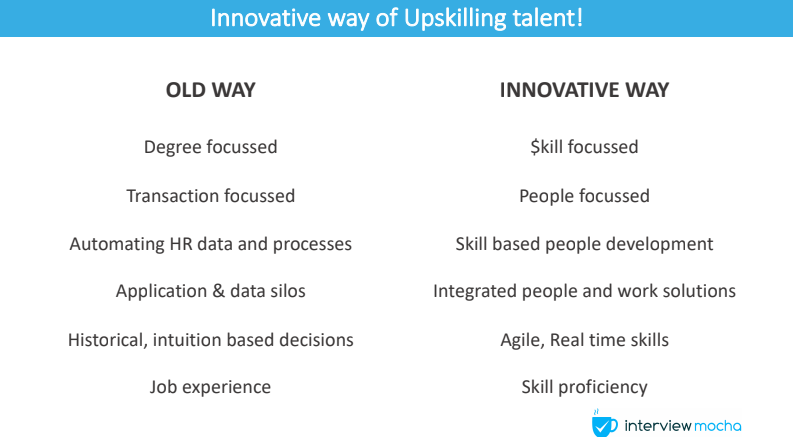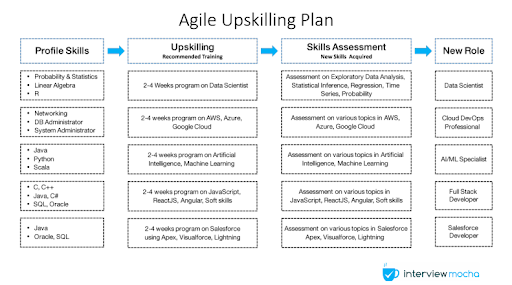Step 1: Understand Why Upskilling Is Important?
The Skills Matrix is evolving at a faster rate than it did just a decade ago. New skills are being introduced almost every year. 10 years ago Data Science, Machine Learning, Augmented Reality was obscure concepts but now are in high demand in many emerging fields. It is now highly imperative for almost all organizations to ensure their employees are equipped with the right skills and adapt to the changing ecosystem.
This is where top upskilling software comes into the picture.
Upskilling employees facilitate a cycle of high productivity and also ensures the employment of the employee. Recommended, since training employees is much more cost-efficient than recruiting new talent, as studies suggest.
For instance, a study by Forbes suggests, 58 million new jobs will be created in Artificial Intelligence by the year 2022. Therefore, implementing employee upskilling in the workplace would be more suitable than going on an aggressive hiring spree.
It wouldn’t be totally wrong to say that the employees themselves prefer learning at work rather than after work. This also helps them with career-enhancing opportunities.
Difference B/W Upskilling And Reskilling?
Upskilling is the process of learning new skills or enhancing your knowledge of a particular skill.
For example - Amanda works as a digital marketing executive and also has an idea about Big Data. It turns out that the organization Amanda is working for needs a Big Data strategist. Amanda hears this news and starts to upskill her knowledge of Big Data to enhance her value within the company.
v/s
Reskilling is the process of learning new skills in order to do a different job.
For example- Cathrine is great at bookkeeping. However, the company she works for has not adopted Quickbook making her job redundant. They expect Cathrine to take a relevant course and get herself certified to stay employable and competitive.
Step 2: Innovative Ways of Upskilling
The traditional method of judging an employee was degree-focused. However, lately, the industry is moving to a more skill-based evaluation of an employee.
Assessing people based on their skills proficiency rather than their job experiences. Making a more people-focused program rather than a transaction-focused one.
Therefore, companies invest in training courses for their employees, so that they can upskill at work.
Step 3: Build A Competency Meter for Upskilling
The first step in creating a competency meter is competency mapping.
Skill mapping consist of the following elements:
- Manpower Distribution
- Identify Key Job Roles
- Identify Skills for Job Roles
- Identify 5 Areas for Each Skill
- Identify Next Gen Skills
These skills should be mapped keeping in mind your current employees and the future growth of your organization.
Skill mapping will also help you to quantify the skills set required for a certain job role.
However, employee skill aspiration is equally important when it comes to learning new skills. It’s pull vs push mechanism. If an employee is interested, they’ll be able to learn more and grasp better, resulting in smooth execution of the process.
Step 4: How To Build An Upskilling Program
There are 4 pillars to a good employee upskilling program:
- Learning ecosystem- It should be immersive and experiential. The learning ecosystem should be easily accessible, i.e., anytime and anywhere learning platforms.
- Skill assessments- Understand what job roles require which skills and have a competency meter ready to quantify them.
- Learning and Development- Research all the emerging technologies in the market. Incubate new skills and design a curriculum for training.
- Partnership and Collaboration- Partner with product companies, have joined venture with clients. Also, collaborate with the content providers.
While the employee learns a new skill the company should make sure that he/she is allocated a project in that field within the next three to six months.
Otherwise, the employee upskilling program would be of no use. As the employee won’t be able to implement his/her knowledge, resulting in zero ROI.
To make things easier for the employees to learn a new skill, they should be someone in the organization that has already executed a project and has a thorough knowledge of the skill.
This person can host webinars for a better understanding of the topic and can answer the questions of the employees learning the skill.
Transform your workforce with iMocha’s AI-driven Upskilling and Reskilling platform—pinpointing skill gaps, enabling precise training, and driving seamless internal mobility.
Step 5: Why Upskilling Program Should Be Agile
Here, at iMocha we recommend running upskilling programs which last up to 2 to 4 weeks. Having an upskilling plan for 2 to 3 months is against the agility upskilling requires.
The minimum duration of the program should be 2 weeks and the maximum should be 4 weeks.
It is recommended for 2 weeks because as more and more time passes you’ll find that the energy of the employee goes down and it becomes monotonous and tiresome after a while. Also, from a millennial point of view, this timeline is highly advisable.
However, if there is a course that requires 2-3 months, then what will you do? You should still try to cut it down to smaller bits. Software companies have shown more success rate once they have moved from the waterfall model to the agile model.
Step 6: How to Measure The ROI Of An Upskilling Program
There’s a Kirkpatrick Model For Training Effectiveness. It has four levels:
- Reaction- The learner’s emotional response to the course, i.e. feedback on the content, the instructor, and learning. This is done as soon as the course is finished.
- Learning- How effectively did the learner obtain the information from the course. Have an assessment at the end of one month, two months or three months to check if the employee still possesses the learning.
- Behavior- Take 360-degree feedback from the employee's team to know if the training made any change in the behavior of the employee on a day-to-day basis. Has the employee become more efficient or not?
- Results- This is determined by the BU and L&D team. They check if the projects are getting implemented better and if the C-SAT score (customer satisfaction score) has become better or not.
Compare the result with the first report of the competency meter. The growth rate will determine the success of the program.
This model along with a good feedback and assessment tool in place will help you figure out the exact ROI.
Step 7: Start Upskilling Today
In the coming ten years, 65% of the jobs will be new. They don’t exist today. To cope up with these new roles, upskilling employees will be a major contributor.
Therefore, upskilling the workforce becomes very important. However, you will need to come up with an employee-focused upskilling plan at the earliest.
Start by taking a survey within your office and ask your employees.
Tell them the skills the company needs in the coming three years and ask them which skills would they like to learn.
Analyze their answers, if the IT employees want to make a switch from Java 6 to Java 8 or they want to get into machine learning. You should also know the reason behind it.
Upskilling should start at the ground level of your company and your employees should be active members of the process.




